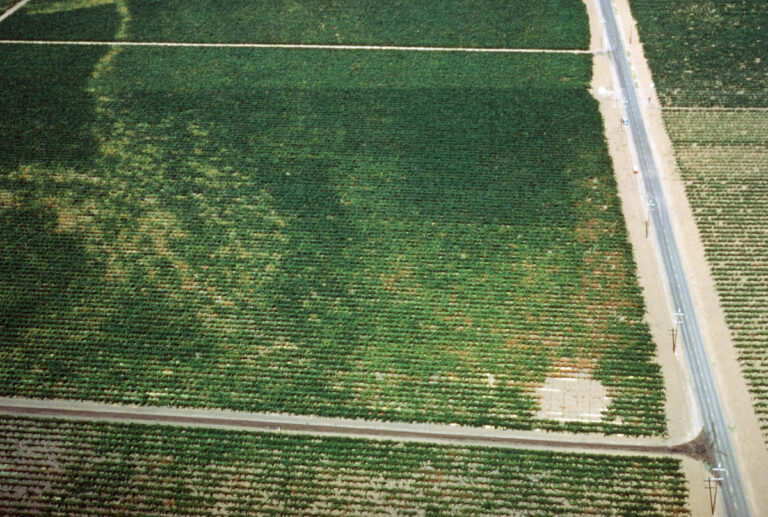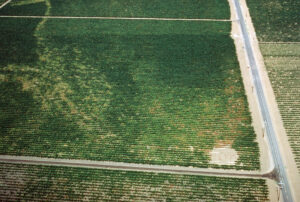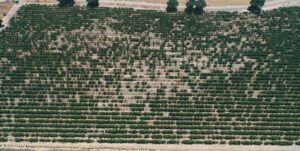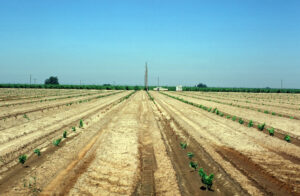
In 2023, California grape growers faced a unique set of challenges that impacted production. A long, wet winter followed by a cooler-than-average spring resulted in delayed budbreak and high mildew pressure that persisted well into the summer. Unusual mid-season rain devastated some southern San Joaquin Valley table grape vineyards, resulting in millions of dollars in losses. Additionally, phenological delays complicated vineyard management decisions and harvest logistics. Despite these challenges, growers and viticulturists remained diligent in quickly identifying issues throughout the season and making decisions to mitigate losses in both yield and quality. Recognizing issues early is the foundation of an effective crop protection program, especially when a problem can be managed before impacting adjacent vineyards. However, when a quick diagnosis cannot be made, it is important to survey the vineyard to collect and record as much data as possible, using available technology when applicable, so damage can be mitigated.
Biotic vs Abiotic
Vineyard issues impacting vine health and fruit production fall into two distinct categories: biotic and abiotic. Problems caused by insects, fungi, bacteria, viruses, rodents, birds and other living organisms are biotic. Abiotic issues include non-living factors like climate, soil compaction, water pH, nutrition, etc. While biotic factors tend to be the most common reason for poor grapevine health, they may not always be the primary cause.
Distinguishing between symptoms of biotic and abiotic vine health issues can take time to sort through since symptoms can have multiple causes. For example, a vineyard may show signs of decline due to root rot infections. However, the real cause may be the presence of hardpan not allowing water to drain. Water accumulating around vine trunks often leads to fungal infection, decline and vine death. Both fungal infections and inadequate water penetration can manifest similar symptoms such as weak vine growth with chlorotic foliage. Identifying the primary cause is important so a solution can be developed and implemented.
Prompt Data Collection and Record Keeping
When diagnosing abnormal plant growth, it is important to collect and record as much data as possible near the time the issue was first observed. The dates of observation(s), symptoms (e.g., abnormal growth), signs (e.g., insects), records, etc. are important for all parties (e.g., grower, PCA, etc.) working on determining the cause of poor growth. Table 1 highlights important information to collect for proper diagnosis. The most basic information focused on vineyard characteristics, such as variety/rootstock, weather, soil, irrigation type, grape tissue analysis, etc., is typical data needed to solve vineyard problems. Sometimes it can take days or weeks of consideration to determine what has affected grapevine health. However, there are times when a problem remains unsolved, even after data have been collected and reviewed by multiple experts.
After collecting basic vineyard information, reports (Table 1) of varying types are important pieces of information for deciphering vineyard issues. Reports that include phenological stage and calendar date, yield and quality, fertilizer and pesticides used, irrigation timings, etc. may give clues about what has happened throughout the season and past years and could help identify a particular issue. The more reports available for review will make solving the problem easier.

Photos are also a great tool because they provide important context and can easily and quickly be shared via email or text. However, there is a difference between a snapshot and a useful photo that can help identify the cause of symptoms. Useful photos show details that can aid in determining a symptom’s cause. For example, a picture of a single leaf on the truck bed probably won’t help identify a problem. A more useful photo would highlight symptomatic foliage showing leaf location on the grapevine, which may highlight the root cause of a problem.
Recording the location in the vineyard where symptoms are observed can be helpful if the problem persists across multiple seasons. Doing so can be as simple as drawing on a vineyard map printed via Google Earth which is freely accessible from both the desktop and mobile application. Alternatively, other mobile applications, such as GPS coordinates, Google Maps or Avenza Maps, can provide the exact location to be included with other records of the problem. There are numerous scouting applications available to collect data, capture photos and record locations in a single platform. The MyEV tool from the Efficient Vineyard Project (www.efficientvineyard.com/) offers these features along with other precision viticulture tools free of charge.

Water, soil and tissue laboratory analyses, when taken annually, help identify trends over seasons. The best approach is to pull samples at specific times (i.e., growth stages) each year so the information is available when decisions need to be made. For example, taking water samples at the beginning of the growing season will help determine how much nitrogen is coming from irrigation water sources. Once known, planned fertilization rates can be adjusted depending on the amounts in the water. Excess N applied during the season without knowing what is in well water is an unnecessary expense, can contribute to poor fruit quality and may further contaminate the aquifer.

Understanding Patterns
Patterns of symptomatic vines are an important piece of information needed to solve the cause of poor vineyard growth. An easy way to identify patterns is the use of aerial imagery (Figure 1) to survey your vineyard. Aerial imagery has improved tremendously and can help detect differences in vine growth, soil and irrigation issues, pest or disease problems and more. Accessing aerial imagery can be as easy as using your own drone to capture footage or hiring a licensed pilot or company to take photos and video for you, of which there is a spectrum of resolutions offered. While an image captured with a standard RGB camera may be useful to visualize obvious patterns within a vineyard (Figure 2), data from aerial imagery captured with a multispectral camera can be transformed into helpful indices of vegetation such as NDVI, which provide a greater degree of insight and help direct scouting in the vineyard. Other specialized sensors can provide additional data for assessing vineyard conditions such as thermal or hyperspectral images.

In instances where patterns of symptoms have been observed over multiple seasons, freely available public satellite data sources such as Sentinel-2 and Landsat 8 may help visualize the spread of the pattern over time. This data is captured at low resolution (10 or 30 meters) at more frequent intervals in comparison to contracted aircraft services which offer very high resolution (< 1 m) but often at fewer time points due to cost. While this data can be downloaded from the web, a GIS mapping software (e.g., qGIS or ArcGIS) is required to process the data and create a map.
Driving and walking vine rows with a soil, vigor (NDVI) or elevation map in hand can be very helpful for assessing problem areas. Surveying the vineyard on foot or with an ATV allows for a closer look at problematic areas. Direct observation may provide additional clues that can complement aerial imagery. Patterns of poor growth found on vineyard edges, down rows or in small patches are sometimes easily solved when those areas are directly observed. For example, Figure 3 shows a young planting with dead grapevines in multiple rows. At first glance, overirrigation or a fungal disease might be the suggested cause of poor growth and/or death. But after further investigation, data that included irrigation scheduling and amounts, soil and plant pathology lab reports and discussions with the grower, it was found an over application of N fertilizer killed the young vines. Once the problem was identified, the vineyard was replanted, and no additional fertilizer was applied during establishment.

Symptom Diagnosis
Diagnosing abnormal growth symptoms is somewhat of an art and a science. When called to identify the cause of poor or unusual growth, a vineyard diagnostician must consider all the scenarios that might be causing symptoms. A methodical approach that results in an accurate diagnosis is important since time is of the essence when considering management strategies to minimize yield and quality losses. Variety, rootstock, vineyard age, soil type(s) and depths, irrigation methods and timings, nutrition, common pests, diseases, climate and many other factors must be considered. A systematic approach must be taken to identify the primary cause that includes symptoms found in the vineyard, including related reports, photos and laboratory analyses. Diagnosing grape pests or diseases can be easier than abiotic causes since three factors need to be present: the pest or disease, grape (i.e., host) and favorable environmental conditions. Often, lack of optimal climatic conditions does not allow for pest or disease outbreaks. In contrast, the cause of abiotic symptoms is more difficult to identify and costs time and resources. Once pests or diseases have been eliminated as causes, a diagnostician must spend time reviewing reports and lab analyses and walking the vineyard looking for patterns and additional clues. A shovel, shears, soil probe and a lot of time will be needed to narrow down the cause.
Finding a Trusted Advisor
Solving vineyard problems that are negatively impacting yield and quality can be daunting, especially when you are working alone. At some point, you may need to consult with an expert. Finding a trusted advisor can also be daunting because there’s often a cost associated with hiring someone. Here are some considerations for finding and hiring a CCA, PCA, private consultant or agricultural forensic consultant.
Before hiring someone, clear goals need to be identified so they can be shared with a prospective consultant. First, what are the yield and quality goals for the vineyard and are they being impacted by the problem? Are you trying to determine what had reduced vineyard performance or what has killed vines? Second, do you want solutions to end the loss of vines and stop the yield decline? Finally, do they have the experience needed to help you solve your vineyard problem? Are they focused on your success or are they just interested in selling you something that will “correct” the problem? If it is a challenging problem, do you feel confident they will tell you the truth if they don’t know what the cause of poor growth is in your vineyard? If you don’t already have a trusted CCA or PCA, it may take some time to interview a consultant you feel confident will help you and have your success in mind.
There are many useful resources available to help figure out the cause of peculiar vineyard symptoms. Books, websites, blogs and webinars are great sources of information for starting your investigation. However, be mindful these types of resources may be specific to a location, climate, variety, production system, etc., which may be different from your situation. If your vineyard health issue needs immediate attention, consider contacting a UC farm advisor, extension specialist, CCA or PCA that specializes in grape production. If your grapevine health issue is caused by a pest or disease, experts can help develop a management program that minimizes crop damage.
Resources
Internet and App
UC Integrated Pest Management: http://ipm.ucanr.edu/index.html
Vineyard Advisor app
Android: https://play.google.com/store/apps/details?id=edu.tamu.agrilife.VineyardAdvisorApp
Apple: https://itunes.apple.com/us/app/vineyard-advisor/id1187381601?mt=8
SoilWeb app: https://play.google.com/store/apps/details?id=com.casoilresourcelab.soilweb
Acres land management app with interactive GIS layers (soil, historical imagery, annual Sentinel-2 NDVI, and elevation): https://acres.com
Efficient Vineyard MyEV tool: https://www.efficientvineyard.com/
Books
Grape Pest Management, 3rd Ed. University of California Publication-ANR 3343
Raisin Production Manual, University of California Publication-ANR 3393
Harvesting and handling California Table Grapes for Market, University of California Bulletin 1913
Compendium of Grape Diseases, Disorders, and Pests, 2nd Ed. APS Press







